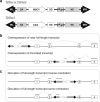Transposon-based screens for cancer gene discovery in mouse models
- PMID: 20478384
- PMCID: PMC2940989
- DOI: 10.1016/j.semcancer.2010.05.003
Transposon-based screens for cancer gene discovery in mouse models
Abstract
Significant emphasis has recently been placed on the characterization of the human cancer genome. This effort has been assisted by the development of new DNA sequencing technologies that allow the genomes of individual tumors to be analyzed in much greater detail. However, the genetic complexity of human cancer has complicated the identification of driver mutations among the more abundant passenger mutations found in tumors. Recently, the Sleeping Beauty (SB) transposon system has been engineered to model cancer in mice. SB-induced tumors are produced by transposon insertional mutagenesis, thus the tagged mutations facilitate the identification of novel cancer genes. This review provides a brief summary of the SB system and its use in modeling cancer in mice.
Copyright © 2010 Elsevier Ltd. All rights reserved.
Figures



Similar articles
-
Identification of cancer driver genes using Sleeping Beauty transposon mutagenesis.Cancer Sci. 2021 Jun;112(6):2089-2096. doi: 10.1111/cas.14901. Epub 2021 May 1. Cancer Sci. 2021. PMID: 33783919 Free PMC article. Review.
-
Identification of Sleeping Beauty transposon insertions in solid tumors using linker-mediated PCR.J Vis Exp. 2013 Feb 1;(72):e50156. doi: 10.3791/50156. J Vis Exp. 2013. PMID: 23407503 Free PMC article.
-
Mouse models of cancer: Sleeping Beauty transposons for insertional mutagenesis screens and reverse genetic studies.Semin Cell Dev Biol. 2014 Mar;27:86-95. doi: 10.1016/j.semcdb.2014.01.006. Epub 2014 Jan 24. Semin Cell Dev Biol. 2014. PMID: 24468652 Free PMC article. Review.
-
Cancer Gene Discovery Utilizing Sleeping Beauty Transposon Mutagenesis.Methods Mol Biol. 2019;1907:161-170. doi: 10.1007/978-1-4939-8967-6_13. Methods Mol Biol. 2019. PMID: 30542999
-
Sleeping beauty: a novel cancer gene discovery tool.Hum Mol Genet. 2006 Apr 15;15 Spec No 1:R75-9. doi: 10.1093/hmg/ddl061. Hum Mol Genet. 2006. PMID: 16651372 Review.
Cited by
-
Review: In vivo models for defining molecular subtypes of the primitive neuroectodermal tumor genome: current challenges and solutions.In Vivo. 2012 Jul-Aug;26(4):487-500. In Vivo. 2012. PMID: 22773561 Free PMC article. Review.
-
The expanding universe of transposon technologies for gene and cell engineering.Mob DNA. 2010 Dec 7;1(1):25. doi: 10.1186/1759-8753-1-25. Mob DNA. 2010. PMID: 21138556 Free PMC article.
-
Exploring transposable elements: new horizons in cancer diagnostics and therapeutics.Mob DNA. 2025 Jul 12;16(1):28. doi: 10.1186/s13100-025-00366-9. Mob DNA. 2025. PMID: 40646624 Free PMC article. Review.
-
Distinct shared and compartment-enriched oncogenic networks drive primary versus metastatic breast cancer.Nat Commun. 2023 Jul 18;14(1):4313. doi: 10.1038/s41467-023-39935-y. Nat Commun. 2023. PMID: 37463901 Free PMC article.
-
Development of a Mouse Model of Prostate Cancer Using the Sleeping Beauty Transposon and Electroporation.Molecules. 2018 Jun 5;23(6):1360. doi: 10.3390/molecules23061360. Molecules. 2018. PMID: 29874846 Free PMC article.
References
-
- Wood LD, Parsons DW, Jones S, Lin J, Sjoblom T, Leary RJ, et al. The genomic landscapes of human breast and colorectal cancers. Science. 2007;318:1108–13. - PubMed
-
- Bittner JJ. Some Possible Effects of Nursing on the Mammary Gland Tumor Incidence in Mice. Science. 1936;84:162. - PubMed
-
- Furth J, Seibold HR, Rathbone RR. Experimental studies on lymphomatosis of mice. Amer. J. Cancer. 1933;19:521–604.
Publication types
MeSH terms
Substances
Grants and funding
LinkOut - more resources
Full Text Sources
Molecular Biology Databases

